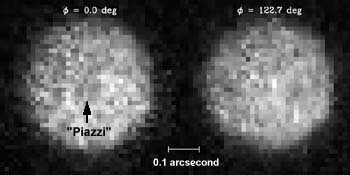
The first known asteroid, 1 Ceres, is also the largest body in the asteroid belt. These Hubble Space Telescope images, taken in ultraviolet light about 3 hours apart, reveal a vague, dark circular feature about 250 kilometers across. Astronomers propose to name it Piazzi, to honor the asteroid's discoverer.
Courtesy Joel W. Parker.
When Guiseppe Piazzi discovered
Ceres on January 1, 1801, he believed he'd found the planet hypothesized
to orbit between Mars and Jupiter. Although Ceres is no planet, it turned
out to be the largest body in the asteroid belt. And now, two centuries
later, astronomers finally have a crude idea of what its surface looks
like.
Thanks to the optical prowess of the Hubble Space Telescope,
a team of observers led by Joel W. Parker (Southwest Research Institute)
captured several images of Ceres on June 25, 1995, in ultraviolet light
(at which HST affords the best resolution). Previous ground-based observations
had resolved Ceres' disk, but only crudely, using adaptive optics; by
contrast, Hubble's images reveal details as small as 50 kilometers across.
Apparently the side of Ceres recorded by HST is rather bland, except
for one dusky dark marking about 250 km across. As Parker and his colleagues
describe in the forthcoming January 2002 issue of the Astronomical
Journal, it's unclear whether this spot is a crater, a dark area,
or something else. But they believe it's a real feature, enough so to
propose that it be named Piazzi.
The 5-hour HST run was not long enough to follow Ceres
through an entire 9.1-hour rotation, but the pictorial coverage suggests
a mean diameter of 950 ± 8 km. From that, as well as previous
mass estimates, the team determined that Ceres' mean density is roughly
2.6 g/cm³ — a reasonable match to the rocky, carbon-enriched
composition suggested by the asteroid's spectrum. Ceres occupies a roughly
circular orbit that averages 2.8 astronomical units (414 million km)
from the Sun.
 0
0
Comments
You must be logged in to post a comment.